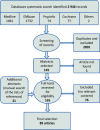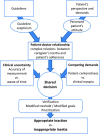The concept and definition of therapeutic inertia in hypertension in primary care: a qualitative systematic review
- PMID: 24989986
- PMCID: PMC4094689
- DOI: 10.1186/1471-2296-15-130
The concept and definition of therapeutic inertia in hypertension in primary care: a qualitative systematic review
Abstract
Background: Therapeutic inertia has been defined as the failure of health-care provider to initiate or intensify therapy when therapeutic goals are not reached. It is regarded as a major cause of uncontrolled hypertension. The exploration of its causes and the interventions to reduce it are plagued by unclear conceptualizations and hypothesized mechanisms. We therefore systematically searched the literature for definitions and discussions on the concept of therapeutic inertia in hypertension in primary care, to try and form an operational definition.
Methods: A systematic review of all types of publications related to clinical inertia in hypertension was performed. Medline, EMbase, PsycInfo, the Cochrane library and databases, BDSP, CRD and NGC were searched from the start of their databases to June 2013. Articles were selected independently by two authors on the basis of their conceptual content, without other eligibility criteria or formal quality appraisal. Qualitative data were extracted independently by two teams of authors. Data were analyzed using a constant comparative qualitative method.
Results: The final selection included 89 articles. 112 codes were grouped in 4 categories: terms and definitions (semantics), "who" (physician, patient or system), "how and why" (mechanisms and reasons), and "appropriateness". Regarding each of these categories, a number of contradictory assertions were found, most of them relying on little or no empirical data. Overall, the limits of what should be considered as inertia were not clear. A number of authors insisted that what was considered deleterious inertia might in fact be appropriate care, depending on the situation.
Conclusions: Our data analysis revealed a major lack of conceptualization of therapeutic inertia in hypertension and important discrepancies regarding its possible causes, mechanisms and outcomes. The concept should be split in two parts: appropriate inaction and inappropriate inertia. The development of consensual and operational definitions relying on empirical data and the exploration of the intimate mechanisms that underlie these behaviors are now needed.
Figures
References
-
- Lewington S, Clarke R, Qizilbash N, Peto R, Collins R. Age-specific relevance of usual blood pressure to vascular mortality : a meta-analysis of individual data for one million adults in 61 prospective studies. Lancet. 2002;360:1903–1913. - PubMed
-
- Mancia G, Laurent S, Agabiti-Rosei E, Ambrosioni E, Burnier M, Caulfield MJ, Cifkova R, Clément D, Coca A, Dominiczak A, Erdine S, Fagard R, Farsang C, Grassi G, Haller H, Heagerty A, Kjeldsen SE, Kiowski W, Mallion JM, Manolis A, Narkiewicz K, Nilsson P, Olsen MH, Rahn KH, Redon J, Rodicio J, Ruilope L, Schmieder RE, Struijker-Boudier HA, Van Zwieten PA. Reappraisal of European guidelines on hypertension management: a European Society of Hypertension Task Force document. Blood Press. 2009;18:308–347. doi: 10.3109/08037050903450468. - DOI - PubMed
Publication types
MeSH terms
Substances
LinkOut - more resources
Full Text Sources
Other Literature Sources
Medical



